Renowned nurseryman and tree specialist, Ronan Nangle shares a positive story of how seeing and selecting trees first hand can contribute to the creation of wonderful places
Two years ago I contributed to an article on difficulties with landscape specifications and the negative impact they are having on our public spaces. That article set in motion a process which continues today and which will produce Ireland’s first landscape quality management system and standards. The new system will address many of the issues which plague our landscape but it won’t solve one of the simplest yet most damaging challenge:
that of the blind specification.
The blind specification is when a professional specifies plant materials from a list with little or no knowledge of the outcome, or for that matter what they are missing out on. Unfortunately, Ireland has more than its fair share of blind specifiers. The evidence is all too apparent, and too often our cities, town and villages are blighted by the sorrowful site of poorly specified, inappropriately sited and ill-maintained trees struggling to cling to life. It breaks my heart.
I am all too aware of why the blind specification takes place. It’s not an intentional practice, it is one necessitated by limited time, budgets and continual pressure from all sides. Even the most well informed and well-intended come under pressure to make hurried choices. So this article is not intended as a critique on poor decision making; it is intended to share a positive perspective, a story of a town created by the sighted with a vision of the future framed by a diversity of well considered and selected trees.
20 years ago, most people would have considered Ballincollig a drab suburb on the western outskirts of Cork city. Though its population was rapidly expanded through the 70s and 80s, it was, like many suburbs around the country, essentially still a village, albeit one that was bursting at the seams.
Ballincollig has a military history dating back to the late 1790s where it produced gunpowder for the British Military. The Barracks was still in operation in 2002 when the gates closed for the last time. The Barracks occupied almost the entire northern part of the village and when it was purchased by O’Flynn Construction in the early 2000s big changes were about to happen. The situation was almost unique, not just in Ireland but across Europe. Rarely did a town with a population of over 25,000 people have the chance to directly influence how its future layout would be planned. Aesthetically the town was going to grow from a village to a European style suburb. Ballincollig was going to grow up, and the landscape was going to play a big part.
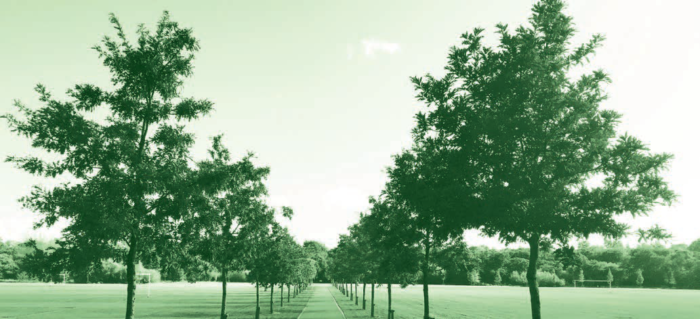
THE DAWNING OF A NEW ERA
By the early 2000s, Ballincollig was still growing rapidly and was about to undergo a radical change. It was fortunate in many ways that the main players in this new era were all keenly interested in the landscape of the town, in how it would actually look. It was lucky that O’Flynn Construction were the developers who bought the barracks. The group were high-end operators, interested in quality, and were both the developers and the builders, which always results in a better end product. They were all too aware of the negative impact of short-term thinking, of blind specifiers. The local area engineer at the time was Ken O’Riordan, who also had a good eye and was interested in aesthetics. He had a clear vision for the town and got things done.
Also of major importance to the greening of the town was the growing involvement of the Tidy Towns committee. An incredibly hard-working, ambitious and motivated group, they
cajoled, pushed and encouraged the area engineers to make improvements at every turn. The group has gone from strength to strength and Ballincollig received a gold medal in the last five National TidyTowns competitions, with a score of 321 in the 2016 competition, just eight points behind the overall winner.
The last key player, and one of the most important is Jack Casey, the local parks superintendent, landscaper, designer and tree expert. His influence on the landscape is
everywhere and it is through his good eye for design, careful plant selection, expert planting and maintenance and astute vision that the greening of the town has been achieved and continues to grow.
TREE SELECTION
Selecting and specifying trees is an art in itself. To do it blindfolded takes a lifetime of practice. The best designers and landscapers I have worked with, both in the public and
private sector, have an area in mind and a clear idea of what they want. Rather than simply listing some names, they visit the nursery to see for themselves. The best specifiers only trust their eyes. The results from this method are always superior to using a blind selection method. Jack Casey is an expert in this method and the results, in my opinion, stand for themselves. His work in the Ballincollig Regional Park is a shining example, taking an underused and overgrown public space and transforming it into a public park of extreme
beauty and purpose.
BALLINCOLLIG REGIONAL PARK
The transformation of the Ballincollig Regional Park from an overgrown and underused public space into the lungs and lifeblood of Ballincollig is an amazing story. The change was
started by Ken O’Riordan and driven on by the resourceful area engineer, Vincent Flourish. The 134 acres of parkland are busy every day of the week and jammed all weekend with
people walking, talking, living and playing together. From its freshly planted car park, to the three acres of well maintained wildflower meadows, nature trails, tarmac walkways, rough running paths, basketball court, astro pitch, playground, exercise areas, history guides, mature woodland and ongoing planting projects, it is a stunning example of how things can and should be done.
The Himalayan birch (Betula utilis Jacquemontii) var. jacquemontii) at the entrance are the first hint of the fantastic selection of trees that grow within. A unique Emperor oak (Quercus dentata ‘Carl Ferris Miller’) on the left as you come into the park will have you guessing, and the multi-stemmed tupelo tree (Nyssa sylvatica) will grab your eye this time of year with its vibrant autumn colours. While the mainstay trees of the park are beech, oak and hornbeam, both existing and newly planted, it is the infill planting and unusual bits
and pieces that will provide interest for most of the year. In the autumn stunning colour is provided by Sorbus dodong ‘Olympic Flame’, upright pin oak (Quercus palustris ‘Green
Pillar’), Freeman’s Maple (Acer x freemanii ‘Autumn Blaze’), and golden birch (Betula costata), while in the spring and summer you have the beautiful Magnolia ‘Heaven Scent’,
yellow flowering buckeye chestnut (Aesculus flava), and the handkerchief tree (Davidia involucrata). Winter interest is provided by the Japanese cornel cherry (Cornus officinalis
‘Robins Pride’) which offers fantastic bright yellow flowers in late January/early February.


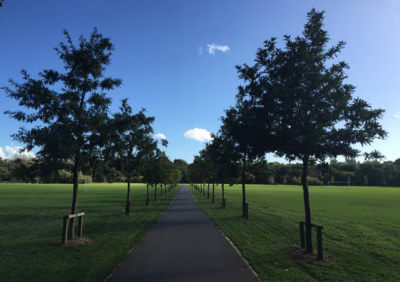

As you are led into the main body of the park you are met by weeping Japanese maples, rhododendrons (Inkarho rootstock) and multi-stemmed snake-bark maple (Acer davidii). The avenues around the playing pitches are planted with hornbeam (Carpinus betulus) and turkey oak (Quercus cerris). These trees give the landscape scale and form and should stand the park in good stead for the next 100 years. As you walk around by the weir an old scrubby area has been cleared away and planted with a fantastic selection of trees: big dawn redwoods (Metasequoia glyptostroboides) grow alongside Chinese red birch (Betula albosinensis ‘Fascination’), dogwoods (Cornus kousa ‘China Girl’), Persian ironwoods (Parrotia persica ‘Vanessa’), ginkgos, sweet chestnuts (Castanea sativa), sweet gums (Liquidambar styraciflua ‘Worplesdon’) and Magnolia kobus amongst others. The selection of trees is fresh and exciting, with both a nod to the past and an eye to the future.
STREET TREES
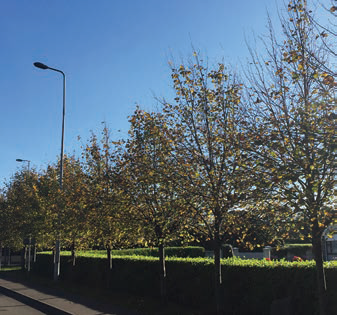

When you have 25,000 people (about 8,000 homes) living in a relatively small space, it takes a lot of trees and greenery to help them blend in. Function, aesthetics and scale are all important in selecting trees that marry these three requirements. In the last 15 years, developers such as O’Flynn Construction, Owen O’Callaghan and O’Brien & O’Flynn Construction and the local council’s parks department under Jack Casey and area engineer Vincent Flourish have done a good job in doing just that. The entrance on the western
side of the town through Greenfields and Coolroe Meadows is planted with a beautiful avenue of field maples (Acer campestre ‘Elsrijk’) and lime trees. They have the effect of drawing your eyes forward and screening the 600 houses that lie behind. Further on to the west, intelligent planting of blue cedar trees, beech, oak and holm oak hide large parks from view. Travelling east you come to three large apartment complexes that could easily have been an eyesore. Instead, smart use of upright oak (Quercus robur fastigiata ‘Koster’) provides a shuttered screen while the two metre high beech hedge on the other side of
the road shields the view of a further 200 houses. As you move toward the town through the broad entrance road plantations of Norway maple (Acer platanoides ‘Emerald Queen’), golden ash (Fraxinus jaspidea) large groups of beech, lime and hornbeam soften almost all the harder elements of a town. The main street itself is planted with field maple, flowering pear (Pyrus calleryana ‘Chanticleer’) and a slow growing small leafed lime (Tilia cordata
‘Rancho’) which are perfectly in scale with the buildings around it. As you go towards Cork city further plantations of maple, limes and birch (Betula pendula), underplanted with thousands of spring bulbs, continue to soften the plethora of houses that lie behind. Individual specimens, such as a magnificent weeping copper beech continue to draw your eye away from the houses.
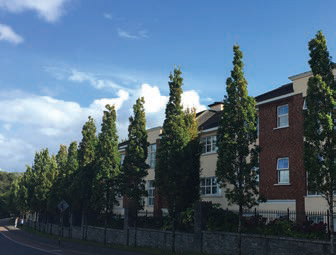

The overall effect of the tree planting makes Ballincollig feel like a European town, but with an Irish accent.
As with all projects like this, there is no end; the work is never done. The Tidy Towns committee and the local parks department will continue to work hard and take on more projects. However, they are passing the baton on with pride, and with the satisfaction of knowing that Ballincollig with its distinctive landscape is now greener, cleaner, and more
environmentally healthy. It is a better place to live in and a shining example of what can be achieved with vision and planning. It really is amazing what a few trees can do.
Now there are benefits to blind specifying. The abstraction, or separation from reality is almost fundamental for competitive tendering, a process that typically results in the lowest price. But as we all know, price and quality are not the same things. The reductionist, cost-focused process of tendering leaves no room for the art, science, complexity and nuance of tree specification. The results are all around us.
If you are a blind specifier, I urge you to do a couple of things. Pick up the phone and arrange a few nursery visits. Ireland’s nurserymen and women are perhaps the most helpful in the world. We are happy to share our knowledge and experience to help you make more well-informed decisions. If you don’t fancy a nursery visit, then do yourself a huge favour and visit Ballincollig. Nothing beats seeing the evidence for yourself. ✽
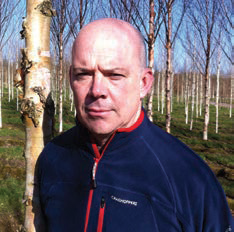  |










